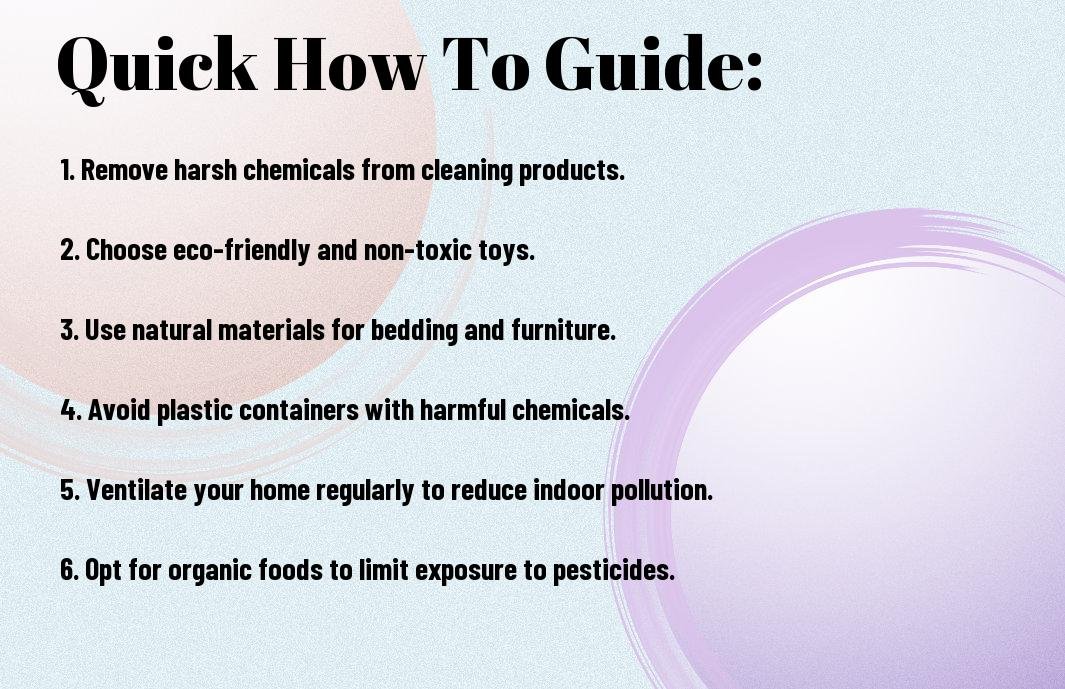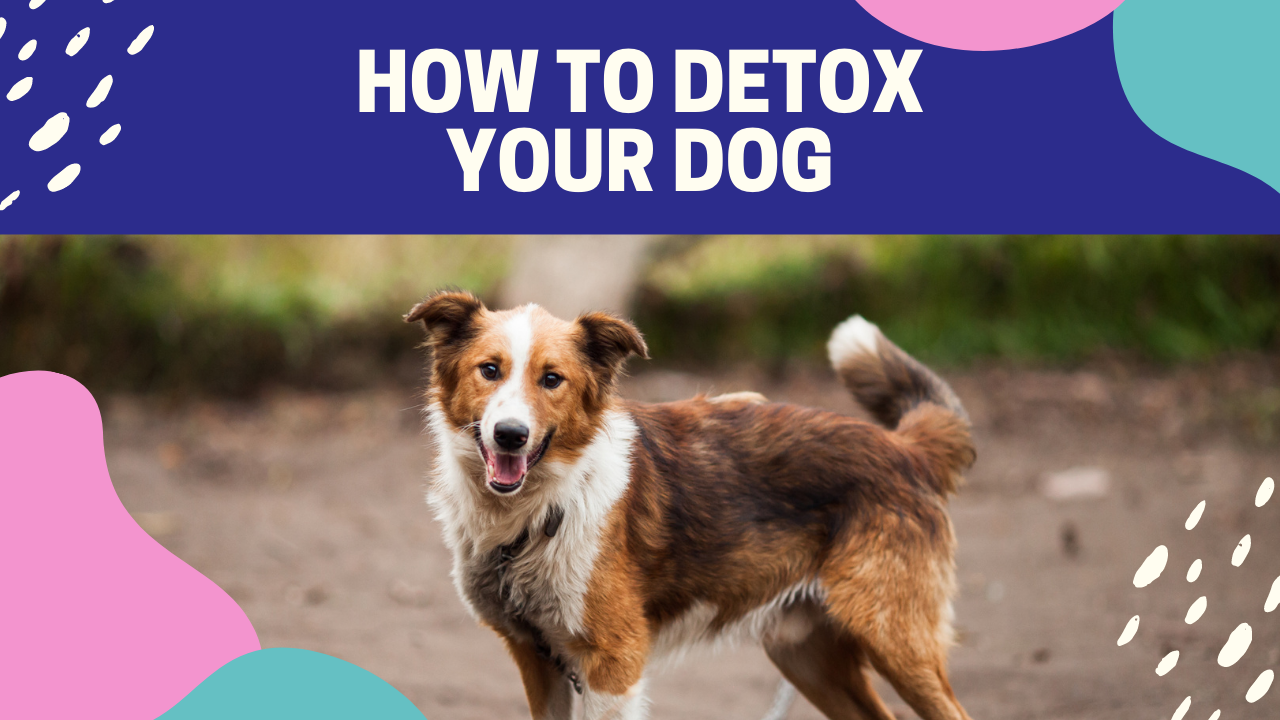You want to ensure the health and safety of your child as they grow and develop. One crucial step you can take is to create a toxin-free environment in your home. Avoiding harmful chemicals and pollutants can have a significant impact on your child’s well-being. In this blog post, we will discuss simple and effective ways to eliminate toxins and promote a healthy living space for your little one.
Table of Contents
Key Takeaways:
- Awareness: Pay attention to the products and materials your child comes into contact with to minimize exposure to toxins.
- Focus on Air Quality: Keep indoor air clean by using air purifiers, opening windows for ventilation, and avoiding products that release harmful chemicals.
- Choose Natural Products: Opt for organic and natural products, such as bedding, clothing, and cleaning supplies, to reduce your child’s exposure to toxins.
- Healthy Diet: Provide your child with a balanced and nutritious diet to support their overall health and minimize the intake of toxins through food and beverages.
- Educate Yourself: Stay informed about common toxins found in everyday products and learn how to make healthier choices for your child’s well-being.

Understanding the Risks of Toxins in Your Child’s Environment
The Impact of Toxins on Childhood Development
For optimal growth and development, it is crucial to create a toxin-free environment for your child. Exposure to toxins during early childhood can have detrimental effects on their physical and cognitive development.
Common Sources of Toxins in the Home
Clearly, there are numerous sources of toxins in the home that can harm your child’s health. These include household cleaning products, pesticides, lead-based paint, and even some plastics that can leach harmful chemicals into the environment.
Home is where your child spends a significant amount of time, making it crucial to identify and eliminate any potential sources of toxins. Pay close attention to items like cosmetics, flame retardants, and air fresheners that may contain harmful substances.
Identifying Hidden Toxins in Your Home
Household Cleaning Products: A Major Culprit
Products used for cleaning your home may contain harmful chemicals like ammonia, chlorine, and phthalates. These toxins can be absorbed through the skin or inhaled, posing a risk to your child’s health.
Toxins in Personal Care Products
Products such as shampoos, soaps, and lotions may contain ingredients like parabens, phthalates, and formaldehyde, which are known to disrupt hormones and may have long-term health effects on your child.
Toxins in personal care products can be especially harmful as they are frequently used directly on the skin, allowing for quicker absorption into the body. It’s important to read labels carefully and opt for natural, organic alternatives to avoid exposing your child to unnecessary toxins.
Hidden Dangers in Toys and Furniture
Dangers lurk in toys and furniture due to materials like lead paint, flame retardants, and volatile organic compounds (VOCs). These substances can leach out over time, exposing your child to hazardous chemicals unknowingly.
Another significant concern is plastic toys and furniture made with polyvinyl chloride (PVC), which can contain phthalates, a group of chemicals linked to developmental issues and other health problems. Be sure to choose toys and furniture made from safer materials like wood or silicone to reduce your child’s exposure to harmful toxins.
How to Purify the Air Your Child Breathes
Despite the excitement of preparing a nursery for your baby, it’s imperative to ensure that the environment is free from toxins. For a comprehensive guide on creating a toxin-free nursery, check out 7 Ways To Create A Toxin-Free Nursery For Your Baby.
The Importance of Air Filtration Systems
Purify the air your child breathes by investing in a quality air filtration system. These systems help remove airborne particles, allergens, and pollutants, ensuring your child breathes clean and healthy air.
Natural Methods for Improving Indoor Air Quality
Breathes easier with natural methods like adding houseplants, using imperative oil diffusers, and opening windows for ventilation. Plants can help remove toxins, while imperative oils provide a natural and pleasant aroma in the nursery.
To further enhance indoor air quality, consider using beeswax candles, which can help purify the air and create a calming ambiance in the room.
Tips for Reducing Air Pollution from Everyday Activities
Even small changes in daily activities can significantly reduce indoor air pollution. Consider the following tips to create a healthier environment for your child:
- Avoid smoking inside the house.
- Use natural cleaning products to minimize chemical exposure.
- Keep the humidity levels in check to prevent mold growth.
For instance, using natural cleaning products instead of those containing harsh chemicals can significantly reduce indoor air pollution. Assume that these small changes can have a big impact on your child’s health.
Creating a Toxin-Free Nursery
Now, when setting up your nursery, it’s crucial to prioritize creating a safe and non-toxic environment for your little one. For detailed guidance on creating a safe home environment, check out Creating a Safe & Open Home Environment.
Choosing Safe and Non-Toxic Furniture
To ensure a toxin-free nursery, opt for furniture made from organic materials such as solid wood or bamboo. Avoid pieces constructed with formaldehyde or other harmful chemicals. Look for Greenguard certified items to guarantee low chemical emissions.
Selecting Toxin-Free Bedding and Mattresses
Nursery bedding and mattresses are crucial components of a toxin-free environment. This is the place where your baby will spend most of their time sleeping and resting. Select bedding made from organic cotton and mattresses free from phthalates, flame retardants, and other harmful substances to ensure a healthy sleeping environment for your child.
Creating a Peaceful and Calming Environment
Clearly, a peaceful and calming environment is critical for your baby’s development. Opt for soft, soothing colors on the walls and incorporate natural elements like plants and wood to create a serene atmosphere. Dimmable lights and a white noise machine can also aid in creating a tranquil space for your little one.

Factors to Consider When Feeding Your Child
Once again, it is crucial to pay attention to what goes into your child’s diet to ensure they are not exposed to toxins that can harm their developing bodies. Here are some factors to consider when feeding your child:
The Dangers of Pesticide-Residue on Fruits and Vegetables
An important aspect to consider when feeding your child is the presence of pesticide residue on fruits and vegetables. Children are more vulnerable to the harmful effects of pesticides due to their smaller size and developing systems. It is crucial to choose organic produce whenever possible to minimize their exposure to these toxins.
How to Choose Safe and Healthy Food Options
One way to ensure your child is getting nutritious and toxin-free food is by opting for whole foods such as fruits, vegetables, whole grains, and lean proteins. Avoid processed and packaged foods that may contain additives and preservatives that can be harmful to your child’s health. It is important to read labels and choose organic options whenever feasible.
Tips for Preparing Toxin-Free Meals and Snacks
Dangers still exist in the preparation of meals and snacks. Be cautious with food storage, opt for stainless steel or glass containers instead of plastic. Cook at lower temperatures to prevent the release of toxins from non-stick cookware. Choose natural sweeteners like honey or maple syrup instead of refined sugar. Perceiving these details while cooking can make a significant difference in your child’s overall health.

How to Make Your Home a Toxin-Free Zone
Not only is it crucial to create a toxin-free environment for your developing child, but it’s also vital for your overall family’s health. Making your home a toxin-free zone involves a few simple steps and adjustments that can have a significant impact on your well-being.
Simple Swaps for a Toxin-Free Kitchen
An easy way to start creating a toxin-free home is by making simple swaps in your kitchen. Replace plastic containers with glass or stainless steel ones, opt for organic produce to avoid pesticides, and choose natural cleaning products over chemical-laden ones.
DIY Cleaning Products for a Toxin-Free Home
You can easily create your own toxin-free cleaning products using ingredients like vinegar, baking soda, and vital oils. These natural alternatives are effective in cleaning and disinfecting your home without exposing your family to harmful chemicals.
Your efforts to switch to DIY cleaning products will not only benefit your family’s health but also contribute to a more sustainable and eco-friendly lifestyle. By reducing your reliance on commercial cleaning products, you’re lowering the amount of toxins being released into the environment.
Tips for Maintaining a Toxin-Free Home
As you strive to maintain a toxin-free home, remember to ventilate your space regularly to reduce indoor air pollutants and keep indoor plants to improve air quality. Regularly dust and vacuum to prevent the accumulation of dust and allergens, and avoid synthetic fragrances that can contain harmful chemicals.
- Monitor air quality in your home with a sensor.
- Inspect cleaning products for toxic ingredients.
- Invest in a good water filtration system for clean drinking water.
- Recognizing the potential sources of toxins in your home is the first step towards creating a healthier living environment for your family.
Summing up
Now armed with knowledge on the harmful effects of toxins on child development and strategies to create a toxin-free environment, it is crucial for parents to take proactive steps to safeguard their child’s well-being. By incorporating simple yet effective changes in nutrition, household products, and living spaces, parents can significantly reduce their child’s exposure to harmful substances and promote a healthier environment for optimal growth and development.
FAQ
Q: Why is it important to create a toxin-free environment for my developing child?
A: Creating a toxin-free environment for your developing child is important because children are more vulnerable to the harmful effects of toxins due to their smaller size and developing bodies. Exposure to toxins can impact their growth, development, and overall health in the long run.
Q: What are some common sources of toxins in the environment that can harm my child?
A: Common sources of toxins in the environment include household cleaning products, pesticides, air pollutants, plastics containing BPA, lead-based paints, and certain personal care products. These toxins can be harmful to your child’s health if not properly addressed.
Q: How can I create a toxin-free environment for my developing child at home?
A: You can create a toxin-free environment for your developing child at home by using natural and non-toxic cleaning products, choosing organic and eco-friendly home furnishings, improving indoor air quality with proper ventilation and air purifiers, and avoiding products containing harmful chemicals.
Q: Are there specific steps I can take to reduce my child’s exposure to toxins in everyday life?
A: Yes, you can reduce your child’s exposure to toxins in everyday life by feeding them organic foods, using glass or stainless steel containers instead of plastic, avoiding products with synthetic fragrances, dusting and vacuuming regularly to reduce dust build-up, and using non-toxic personal care products.
Q: How can I ensure that my child’s school or daycare is a toxin-free environment?
A: You can ensure that your child’s school or daycare is a toxin-free environment by encouraging the use of non-toxic cleaning products, providing organic snacks for your child, promoting good indoor air quality through proper ventilation, and advocating for a toxin-free policy within the institution.
Recent Posts
Revitalize your health with an innovative detox approach offered by Root Wellness. This powerful solution enhances wellness through natural ingredients like zeolite and silica, effectively cleansing...
Roots Clean Slate Erfahrungen Revitalize With Bioavailable Silicon
Revitalizing your health begins with a natural approach to removing harmful substances. Detoxification can pave the way for a more vibrant life through effective cleansing methods. Bioavailable...

